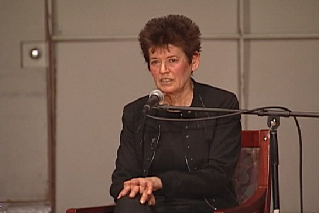The Landscape of Memory
Ursula von Rydingsvard in conversation with Debra Bricker Balken on BUniverse

Watch Debra Bricker Balken and sculptor Ursula von Rydingsvard on BUniverse.
The School of Visual Arts Contemporary Lecture Series presents art historian, theorist, and critic Debra Bricker Balken and sculptor Ursula von Rydingsvard — famous for her cedar monuments — discussing the sculptor’s life and career, as well as the effects of subjectivity and psychology on contemporary art.
In introducing von Rydingsvard, Balken describes the role of the sculptor’s early life in her art. Von Rydingsvard’s family fled Poland during World War II and spent a portion of the postwar period in refugee camps before immigrating to the United States. The sculptor’s constructions, Balken notes, are tied to her landscape of memory and her relocations of fleeting, indelible experiences.
Showing slides of her work, von Rydingsvard then comments on her creative process and technical conventions, and often characterizes her pieces as being flirtatious, seductive, sensuous, and provocative. Her immense statues are usually made of wood, but sometimes incorporate various media, including a cow stomach.
In the discussion between Balken and von Rydingsvard, the sculptor describes her influences, including minimalist artist Ronald Bladen, although she says that she does not subscribe to the conventions of any specific artistic movement.
About the speaker:
Debra Bricker Balken is an independent curator and writer; she has organized numerous exhibitions of American modernism and contemporary art for major museums nationally. Her books include Philip Guston’s Poor Richard and Abstract Expressionism (Movements in Modern Art Series), as well as many exhibition catalogues. She is the recipient of an inaugural Clark Fellowship at the Clark Art Institute, a Senior Fellowship from the Daedalus Foundation, and a Rockefeller Foundation Fellowship. She is currently completing a study of the art critic Harold Rosenberg for the University of Chicago Press, made possible through grants from the Getty Research Institute, Creative Capital, and the Andy Warhol Foundation for the Arts. She has taught at numerous universities, including Brown University, the Institute of Fine Arts of New York University, the Rhode Island School of Design, and the Williams College Graduate Program in Art History.
Ursula von Rydingsvard was born in Deensen, Germany, in 1942. She received a B.A. and an M.A. from the University of Miami, Coral Gables, in 1965 and an M.F.A. from Columbia University, in 1975. In 1991, she was awarded an honorary doctorate from the Maryland Institute College of Art. Von Rydingsvard builds towering cedar structures that are shaped by sharp and lyrical cuts and glued together to form sensuous, puzzle-like surfaces. While abstract at its core, von Rydingsvard’s work takes visual cues from the landscape, the human body, and everyday objects. She has received many awards, including a Joan Mitchell Award (1997); an Academy Award, from the American Academy of Arts and Letters (1994); fellowships from the John Simon Guggenheim Foundation (1983) and the National Endowment for the Arts (1979, 1986); and exhibition prizes from the International Association of Art Critics (1992, 2000). Major exhibitions have been at Madison Square Park, New York (2006); the Neuberger Museum, SUNY Purchase, New York (2002); and Storm King Art Center, Mountainville, New York (1992). Von Rydingsvard lives and works in New York.
Comments & Discussion
Boston University moderates comments to facilitate an informed, substantive, civil conversation. Abusive, profane, self-promotional, misleading, incoherent or off-topic comments will be rejected. Moderators are staffed during regular business hours (EST) and can only accept comments written in English. Statistics or facts must include a citation or a link to the citation.